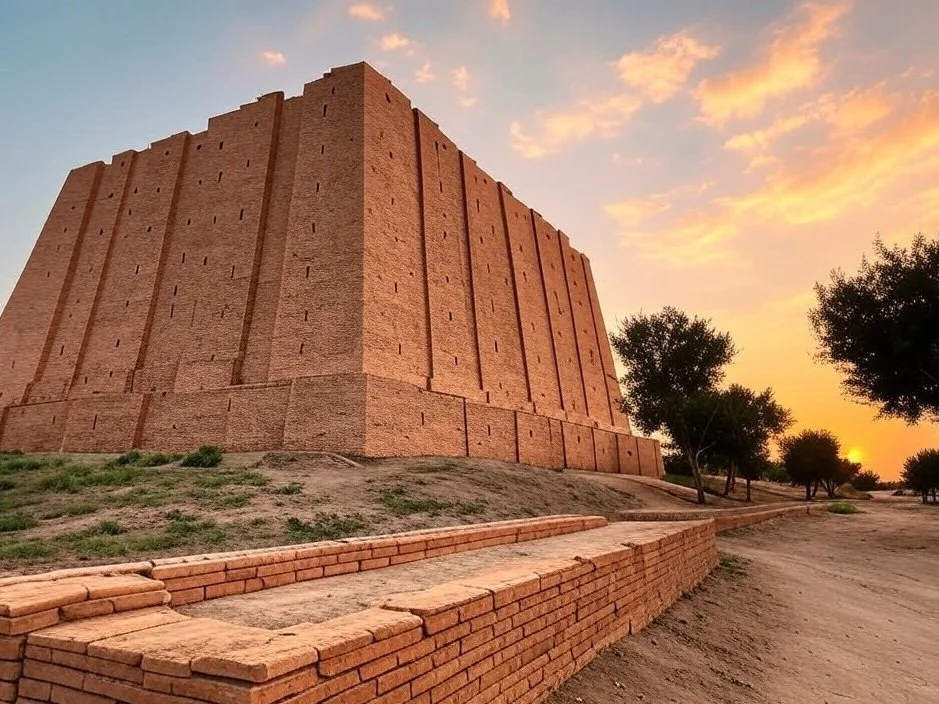Introduction
The ziggurats of Mesopotamia are among the most iconic and enduring symbols of ancient civilization. These massive stepped structures, built by the Sumerians, Babylonians, and Assyrians, served as temples to the gods and played a central role in the religious and cultural life of Mesopotamian society. This exploration delves into the construction and purpose of ziggurats, their cultural and religious significance, and how they reflected the values and organization of Mesopotamian society.
Construction of Ziggurats
Architectural Design:
Stepped Structure: Ziggurats were characterized by their stepped or terraced design, with multiple levels receding as they rose. The core was typically made of mud bricks, while the exterior was faced with baked bricks to protect against the elements.
Temple at the Summit: At the top of each ziggurat was a small temple or shrine, believed to be the dwelling place of the city's patron deity. This elevated position symbolized the connection between heaven and earth.
Building Techniques:
Materials and Labor: The construction of ziggurats required vast quantities of mud bricks, which were made from locally available clay and straw. The labor force consisted of skilled workers and laborers, often organized through corvée labor systems.
Engineering Feats: The construction of ziggurats demonstrated advanced engineering skills, including the use of buttresses and drainage systems to ensure stability and prevent water damage.
Notable Examples:
Great Ziggurat of Ur: One of the best-preserved ziggurats, the Great Ziggurat of Ur, was built around 2100 BCE by King Ur-Nammu. It was dedicated to the moon god Nanna and featured a massive base with three tiers.
Etemenanki: Often associated with the biblical Tower of Babel, Etemenanki was a ziggurat in Babylon dedicated to the god Marduk. It was a towering structure with seven tiers, symbolizing the seven heavens.
Purpose and Function of Ziggurats
Religious Significance:
Temples to the Gods: Ziggurats served as temples where priests conducted rituals and offerings to honor the city's patron deity. These rituals were believed to ensure the favor of the gods and the prosperity of the city.
Axis Mundi: The ziggurat was considered the axis mundi, or the cosmic axis, connecting the earthly realm with the divine. It was a sacred space where the gods could descend to interact with humans.
Cultural and Social Role:
Centers of Worship: Ziggurats were the focal points of religious life, attracting pilgrims and worshippers from across the region. They were also sites of major festivals and ceremonies.
Symbol of Power: The construction of a ziggurat was a demonstration of a ruler's piety and power. It reflected the ruler's ability to mobilize resources and labor, as well as their dedication to the gods.
Economic and Administrative Functions:
Storage and Distribution: Some ziggurats included storage facilities for grain and other goods, which were distributed to the population during times of need. This function reinforced the temple's role in the economic life of the city.
Administrative Centers: The temple complexes associated with ziggurats often housed administrative offices and archives, where records of trade, taxation, and legal matters were kept.
Cultural and Religious Significance
Reflection of Society’s Values:
Hierarchical Structure: The ziggurat's towering presence and hierarchical design mirrored the social hierarchy of Mesopotamian society, with the king and priests at the top, followed by merchants, artisans, and laborers.
Community Identity: Each ziggurat was a symbol of the city's identity and its special relationship with its patron deity. It fostered a sense of community and shared purpose among the inhabitants.
Cosmology and Mythology:
Cosmic Order: The ziggurat embodied the Mesopotamian worldview, which emphasized the order and harmony of the cosmos. It was a physical manifestation of the belief in a structured universe governed by divine will.
Mythological Narratives: Ziggurats were often associated with mythological narratives, such as the descent of the gods from heaven or the creation of the world. These stories reinforced the religious and cultural significance of the structures.
Art and Iconography:
Decorative Elements: Ziggurats were adorned with decorative elements, including glazed bricks, reliefs, and inscriptions. These artistic features depicted religious scenes, symbols, and texts, enhancing the sacred atmosphere of the temple.
Symbolic Imagery: The imagery and iconography associated with ziggurats often included symbols of power, fertility, and protection, reflecting the values and aspirations of Mesopotamian society.
Conclusion
The ziggurats of Mesopotamia were more than just architectural marvels; they were profound expressions of the religious, cultural, and social values of ancient Mesopotamian civilization. As temples to the gods, they served as centers of worship, symbols of power, and focal points of community identity. The construction and maintenance of ziggurats required advanced engineering skills, significant resources, and a highly organized society. Through their monumental presence and intricate design, ziggurats embodied the Mesopotamian worldview, connecting the earthly realm with the divine and reflecting the hierarchical and ordered nature of their society. As enduring symbols of human ingenuity and devotion, the ziggurats of Mesopotamia continue to captivate and inspire, offering valuable insights into the origins of urban civilization and the enduring quest for spiritual and cultural expression.







